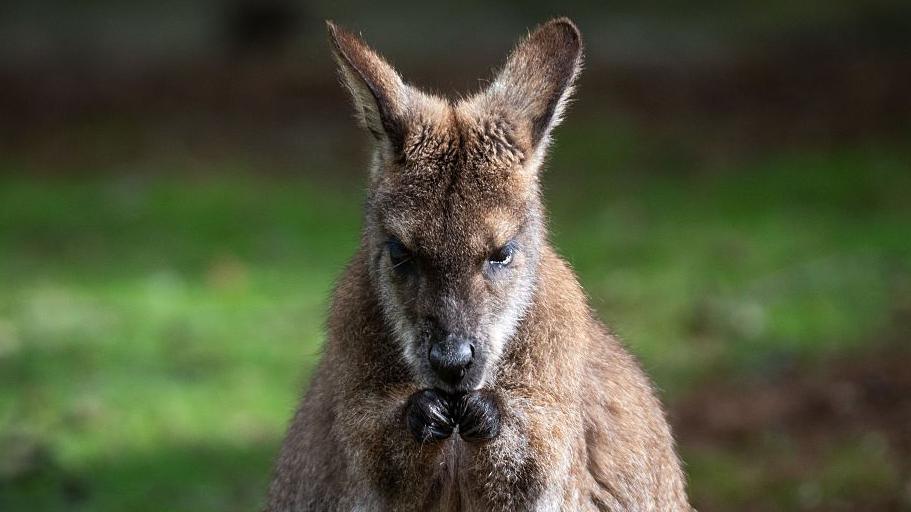UK: How common are wild wallabies in East Anglia?

London: Suffolk and Norfolk residents have been captivated this week after a small wallaby was spotted on the border near Bungay, as well as in Halesworth. While the species is not native to the UK, and it is not clear where it has come from, there are some wild colonies across the country. So just how many could there be in Suffolk and Norfolk?
Wallabies are primarily found in Australia and nearby islands, and are members of the Macropod family along with kangaroos.
They are typically small to medium-sized and have powerful hind legs that they use to bound along at high speeds and jump distances.
Their diet typically consists of grass, herbs, roots, tree leaves, and other foliage.
A research paper in 2020 by Holly M. English of University College Dublin and Anthony Caravaggi of the University of South Wales looked into wallabies in the UK.
They believed wallabies were likely first brought to the UK for zoos as well as for private collections in the late 19th Century.
From then, it is believed that during the World Wars, some were released into the countryside as people were unable to look after them.
Some of those wallabies that were released went on to form a population in the Peak District; however, they slowly died out over the years.
There is a large population of wallabies living on the Isle of Man.
It is thought there are likely up to 1,000 of them living in an area of the isle called the Ballaugh Curragh.
It is believed they were brought to a wildlife zoo in 1965 before some managed to escape and went on to breed.
Surveys in 2023 and 2024 revealed the huge numbers living in the area with the use of thermal-imaging cameras.
The study found there was a strong correlation with wallaby presence being linked to “cover of some sort”, primarily woodland.
Helen Pearson, head of animal studies at Suffolk Rural, which has its own wallabies, said they could survive “quite well” in the UK.
“They all come from Australia,” she explained.
“They live in shrubland out there, so as much as you think Australia is quite hot, they cope quite well in our climate. They’re really hardy animals.
“I know that on the Isle of Man, there is a wild population of wallabies because of how well they can survive.
“Unfortunately, it does make them an invasive species because they are not native to here.”
While the animals are non-indigenous to the UK, it is unknown the impact they could be having on native animal and plant life, according to the 2020 research paper.
It is currently unknown just where the wallaby on the Suffolk and Norfolk border has come from.
“This one in particular in Suffolk, at one point it would have been in captivity, but I obviously don’t know how long ago or if it’s just escaped, or if it’s been there for a long time,” Ms Pearson said.
“My guess, if you’ve only just seen it, then it’s just escaped, but I don’t know where from.”
Mr Pearson believed the wallaby was of the same kind as the ones at the college, a red-necked wallaby also known as a Bennett’s wallaby.
Ms Pearson said she had not heard of any wild wallaby sightings in Suffolk before.
However, the 2020 research paper mapped sightings of wallabies across the UK, and it found 95 confirmed sightings between 2008 and 2018, most of which were in the south of England.
There were also 64 media reports of sightings during that time.
A map of their findings suggested there had been some sightings in both Norfolk and Suffolk over the years, as well as in nearby Essex, but exact locations were not mentioned.
While this is the first reported wallaby sighting in some time, there were other wallaby sightings near Halstead in Essex in 2018, as well as in Glemsford in Suffolk.
At the time, it was believed they had escaped the year prior from a travelling carnival.
There was also a captive wallaby named Sheila that escaped her home in Norwich in 2023, but she was later found.
It is considered illegal to release a wallaby into the wild under the Wildlife and Countryside Act 1981.
This is because they are not native to the UK, and the Act protects wild animals and plants in the UK.
Anyone caught doing this could face imprisonment or a fine.
Ms Pearson offered advice to anyone who sees the wallaby again.
“Try and, if possible, keep eyes on it from a distance if you can because as soon as you lose sight of it, it could be another week until someone sees it,” she said.
“Out there in the woodlands, fields and things, it could very easily disappear quite quickly.
“I used to be a zookeeper, and when things like this happen, you want to know that someone can see it at all times.
“Keep eyes and ring maybe the RSPCA or local vet, and hopefully they can assemble a team.
“I wouldn’t approach it; they’ve got a really big kick on them, which could cause you some injuries, so it’s best to leave it alone.”
Suffolk Police also encouraged anyone who saw it to contact them.





